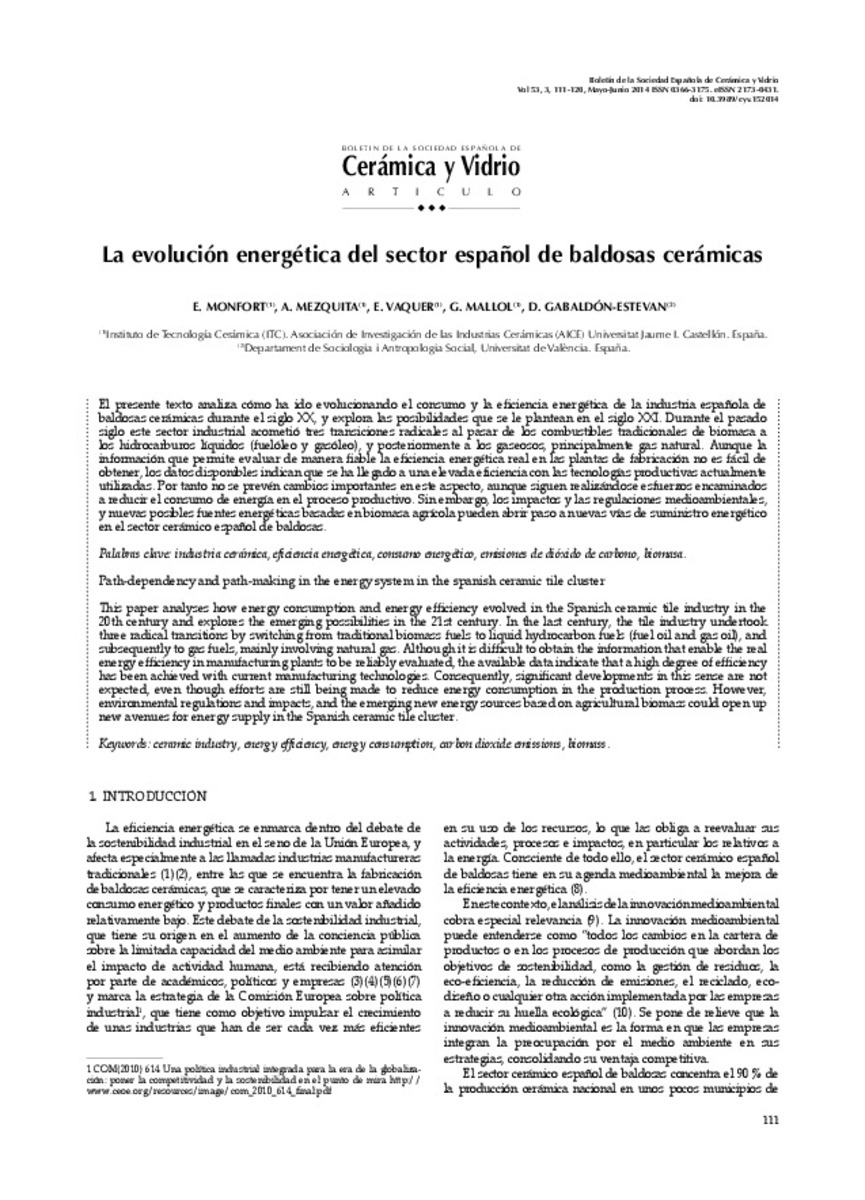Mostrar el registro sencillo del ítem
La evolución energética del sector español de baldosas cerámicas
| dc.contributor.author | Monfort, Eliseo | |
| dc.contributor.author | Mezquita, Ana | |
| dc.contributor.author | Vaquer, A. | |
| dc.contributor.author | Mallol Gasch, Gustavo | |
| dc.contributor.author | Gabaldón Estevan, Daniel | |
| dc.date.accessioned | 2015-05-21T11:52:44Z | |
| dc.date.available | 2015-05-21T11:52:44Z | |
| dc.date.issued | 2014-05 | |
| dc.identifier.issn | 0366-3175 | |
| dc.identifier.issn | 2173-0431 | |
| dc.identifier.uri | http://hdl.handle.net/10234/121455 | |
| dc.description.abstract | El presente texto analiza cómo ha ido evolucionando el consumo y la eficiencia energética de la industria española de baldosas cerámicas durante el siglo XX, y explora las posibilidades que se le plantean en el siglo XXI. Durante el pasado siglo este sector industrial acometió tres transiciones radicales al pasar de los combustibles tradicionales de biomasa a los hidrocarburos líquidos (fuelóleo y gasóleo), y posteriormente a los gaseosos, principalmente gas natural. Aunque la información que permite evaluar de manera fiable la eficiencia energética real en las plantas de fabricación no es fácil de obtener, los datos disponibles indican que se ha llegado a una elevada eficiencia con las tecnologías productivas actualmente utilizadas. Por tanto no se prevén cambios importantes en este aspecto, aunque siguen realizándose esfuerzos encaminados a reducir el consumo de energía en el proceso productivo. Sin embargo, los impactos y las regulaciones medioambientales, y nuevas posibles fuentes energéticas basadas en biomasa agrícola pueden abrir paso a nuevas vías de suministro energético en el sector cerámico español de baldosas. | ca_CA |
| dc.description.abstract | This paper analyses how energy consumption and energy efficiency evolved in the Spanish ceramic tile industry in the 20th century and explores the emerging possibilities in the 21st century. In the last century, the tile industry undertook three radical transitions by switching from traditional biomass fuels to liquid hydrocarbon fuels (fuel oil and gas oil), and subsequently to gas fuels, mainly involving natural gas. Although it is difficult to obtain the information that enable the real energy efficiency in manufacturing plants to be reliably evaluated, the available data indicate that a high degree of efficiency has been achieved with current manufacturing technologies. Consequently, significant developments in this sense are not expected, even though efforts are still being made to reduce energy consumption in the production process. However, environmental regulations and impacts, and the emerging new energy sources based on agricultural biomass could open up new avenues for energy supply in the Spanish ceramic tile cluster. | ca_CA |
| dc.format.extent | 10 p. | ca_CA |
| dc.format.mimetype | application/pdf | ca_CA |
| dc.language.iso | spa | ca_CA |
| dc.publisher | Elsevier | ca_CA |
| dc.relation.isPartOf | Boletín de la Sociedad Española de Cerámica y Vidrio Vol 53, 3, (2014) | ca_CA |
| dc.rights | © SOCIEDAD ESPAÑOLA DE CERÁMICA Y VIDRIO | ca_CA |
| dc.rights.uri | http://rightsstatements.org/vocab/InC/1.0/ | * |
| dc.subject | industria cerámica | ca_CA |
| dc.subject | eficiencia energética | ca_CA |
| dc.subject | consumo energético | ca_CA |
| dc.subject | emisiones de dióxido de carbono | ca_CA |
| dc.subject | biomasa | ca_CA |
| dc.subject | ceramic industry | ca_CA |
| dc.subject | energy efficiency | ca_CA |
| dc.subject | energy consumption | ca_CA |
| dc.subject | carbon dioxide emissions | ca_CA |
| dc.subject | biomass | ca_CA |
| dc.title | La evolución energética del sector español de baldosas cerámicas | ca_CA |
| dc.type | info:eu-repo/semantics/article | ca_CA |
| dc.identifier.doi | http://dx.doi.org/10.3989/cyv.152014 | |
| dc.rights.accessRights | info:eu-repo/semantics/openAccess | ca_CA |
| dc.relation.publisherVersion | http://boletines.secv.es/upload/2014070792201.201453111.pdf | ca_CA |
| dc.type.version | info:eu-repo/semantics/publishedVersion |
Ficheros en el ítem
Este ítem aparece en la(s) siguiente(s) colección(ones)
-
QUI_Articles [296]







